Ardal O'Hanlon is an Irish comedian, actor, and author. He played Father Dougal McGuire in Father Ted (1995–1998), George Sunday/Thermoman in My Hero (2000–2006), and DI Jack Mooney in Death in Paradise (2017–2020). His novel The Talk of the Town was published in 1998.
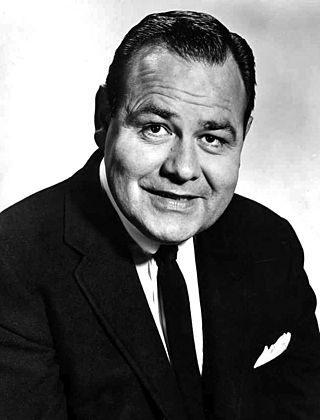
Jonathan Harshman Winters III was an American comedian, actor, author, television host, and artist. He started performing as a stand up comedian before transitioning his career to acting in film and television. Winters received numerous accolades including two Grammy Awards, a Primetime Emmy Award, as well as a star on the Hollywood Walk of Fame in 1960, the American Academy of Achievement in 1973, and the Mark Twain Prize for American Humor in 1999.
Richard Dorian Goodman, known as Dickie Goodman, was an American music and record producer born in Brooklyn, New York. He is best known for inventing and using the technique of the "break-in", an early precursor to sampling, that used brief clips of popular records and songs to "answer" comedic questions posed by voice actors on his novelty records. He also wrote and produced some original material, most often heard on the B-sides of his break-in records. He died from suicide by gunshot on December 6, 1989.
In ufology, the psychosocial hypothesis, abbreviated PSH, argues that at least some UFO reports are best explained by psychological or social means. It is often contrasted with the better-known extraterrestrial hypothesis (ETH), and is particularly popular among UFO researchers in the United Kingdom, such as David Clarke, Hilary Evans, the editors of Magonia magazine, and many of the contributors to Fortean Times magazine. It has also been popular in France since the publication in 1977 of a book written by Michel Monnerie, Et si les ovnis n'existaient pas?.

Little green men is the stereotypical portrayal of extraterrestrials as little humanoid creatures with green skin and sometimes with antennae on their heads. The term is also sometimes used to describe gremlins, mythical creatures known for causing problems in airplanes and mechanical devices.
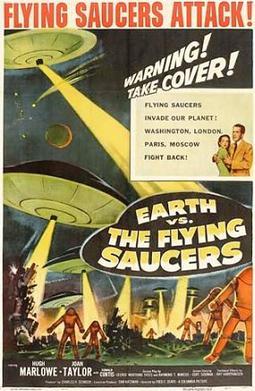
Earth vs. the Flying Saucers is a 1956 American science fiction film from Columbia Pictures. It was produced by Charles H. Schneer, directed by Fred F. Sears, and stars Hugh Marlowe and Joan Taylor. The stop-motion animation special effects were created by Ray Harryhausen. The storyline was suggested by the bestselling 1953 non-fiction book Flying Saucers from Outer Space by Maj. Donald Keyhoe. The film was released as a double feature with The Werewolf.
The Flying Saucer is a 1950 independently made American black-and-white science fiction spy film drama. It was written by Howard Irving Young, from an original story by Mikel Conrad, who also produced, directed, and stars with Pat Garrison and Hantz von Teuffen. The film was first distributed in the U.S. by Film Classics and later re-released in 1953 by Realart Pictures, on a double-bill with Atomic Monster.
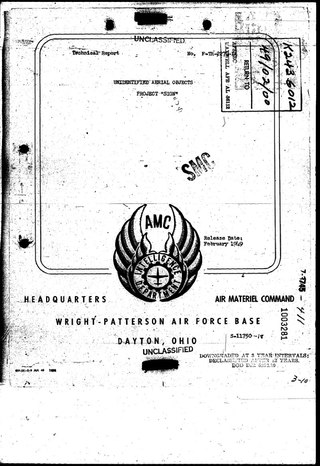
Project Sign or Project Saucer was an official U.S. government study of unidentified flying objects (UFOs) undertaken by the United States Air Force (USAF) and active for most of 1948. It was the precursor to Project Grudge.
A UFO religion is any religion in which the existence of extraterrestrial (ET) entities operating unidentified flying objects (UFOs) is an element of belief. Typically, adherents of such religions believe the ETs to be interested in the welfare of humanity which either already is, or eventually will become, part of a pre-existing ET civilization. Other religions predate the UFO era of the mid 20th century, but incorporate ETs into a more supernatural worldview in which the UFO occupants are more akin to angels than physical aliens, but this distinction may be blurred within the overall subculture. These religions have their roots in the tropes of early science fiction and weird fiction writings, in ufology, and in the subculture of UFO sightings and alien abduction stories. Historians have considered the Aetherius Society, founded by George King, to be the first UFO religion.

In ufology, conspiracy theory, science fiction, and comic book stories, claims or stories have circulated linking UFOs to Nazi Germany. The German UFO theories describe supposedly successful attempts to develop advanced aircraft or spacecraft prior to and during World War II, further asserting the post-war survival of these craft in secret underground bases in Antarctica, South America, or the United States, along with their creators.
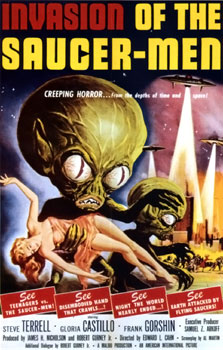
Invasion of the Saucer Men, is a 1957 black-and-white comic science fiction/comedy horror film produced by James H. Nicholson for release by American International Pictures. The film was directed by Edward L. Cahn and stars Stephen Terrell, Gloria Castillo, Raymond Hatton and Frank Gorshin.

A flying saucer is a descriptive term for a type of flying craft having a disc or saucer-shaped body, commonly used generically to refer to an anomalous flying object. The term was coined in 1947 but has generally been supplanted since 1952 by the United States Air Force term unidentified flying objects. Early reported sightings of unknown "flying saucers" usually described them as silver or metallic, sometimes reported as covered with navigation lights or surrounded with a glowing light, hovering or moving rapidly, either alone or in tight formations with other similar craft, and exhibiting high maneuverability.
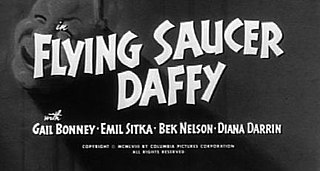
Flying Saucer Daffy is a 1958 short subject directed by Jules White starring American slapstick comedy team The Three Stooges. It is the 187th entry in the series released by Columbia Pictures starring the comedians, who released 190 shorts for the studio between 1934 and 1959.

"The Flying Saucer" is a novelty record, the first of a series of break-in records released by Bill Buchanan and Dickie Goodman. The song is considered to be an early example of a mashup, featuring segments of popular songs intertwined with spoken "news" commentary to tell the story of a visit from a flying saucer.

The Kenneth Arnold UFO sighting occurred on June 24, 1947, when private pilot Kenneth Arnold claimed that he saw a string of nine, shiny unidentified flying objects flying past Mount Rainier at speeds that Arnold estimated at a minimum of 1,200 miles an hour (1,932 km/h). This was the first post-World War II sighting in the United States that garnered nationwide news coverage and is credited with being the first of the modern era of UFO sightings, including numerous reported sightings over the next two to three weeks. Arnold's description of the objects also led to the press quickly coining the terms flying saucer and flying disc as popular descriptive terms for UFOs.

They Knew Too Much About Flying Saucers is a 1956 book by paranormal author Gray Barker. It was the first book to allege that "Men in Black" were covering up the existence of flying saucers.

The Flight 105 UFO sighting occurred on July 4, 1947, when three crew members aboard a United Airlines flight reported seeing multiple unidentified objects in the skies over the Pacific Northwest. A week prior, private pilot Kenneth Arnold had reported seeing similar objects nearby – a sighting that was followed by nearly 800 "copycat" reports during the summer of 1947. Four days after the Flight 105 sighting, Roswell Army Air Field issued a press release stating that they had recovered a "flying disc"; that statement was quickly retracted after the crashed object was identified as a conventional weather balloon. The following month, on July 29, an air crew flying the same route also reported unidentified objects.
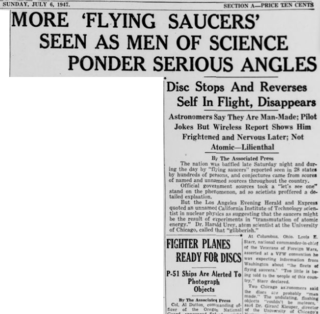
The 1947 flying disc craze was a rash of unidentified flying object reports in the United States that were publicized during the summer of 1947. The craze began on June 24, when media nationwide reported civilian pilot Kenneth Arnold's story of witnessing disc-shaped objects which headline writers dubbed "Flying Saucers". Such reports quickly spread throughout the United States; historians would later chronicle at least 800 "copycat" reports in subsequent weeks, while other sources estimate the reports may have numbered in the thousands.

The Report on Unidentified Flying Objects is a 1956 book by then-retired Air Force UFO investigator Edward J. Ruppelt, detailing his experience running Project Bluebook. The book was noted for its suggestion that a few UFO sightings might be linked to spikes of atomic radiation. Contemporary media summarized four topics discussed in the book:














